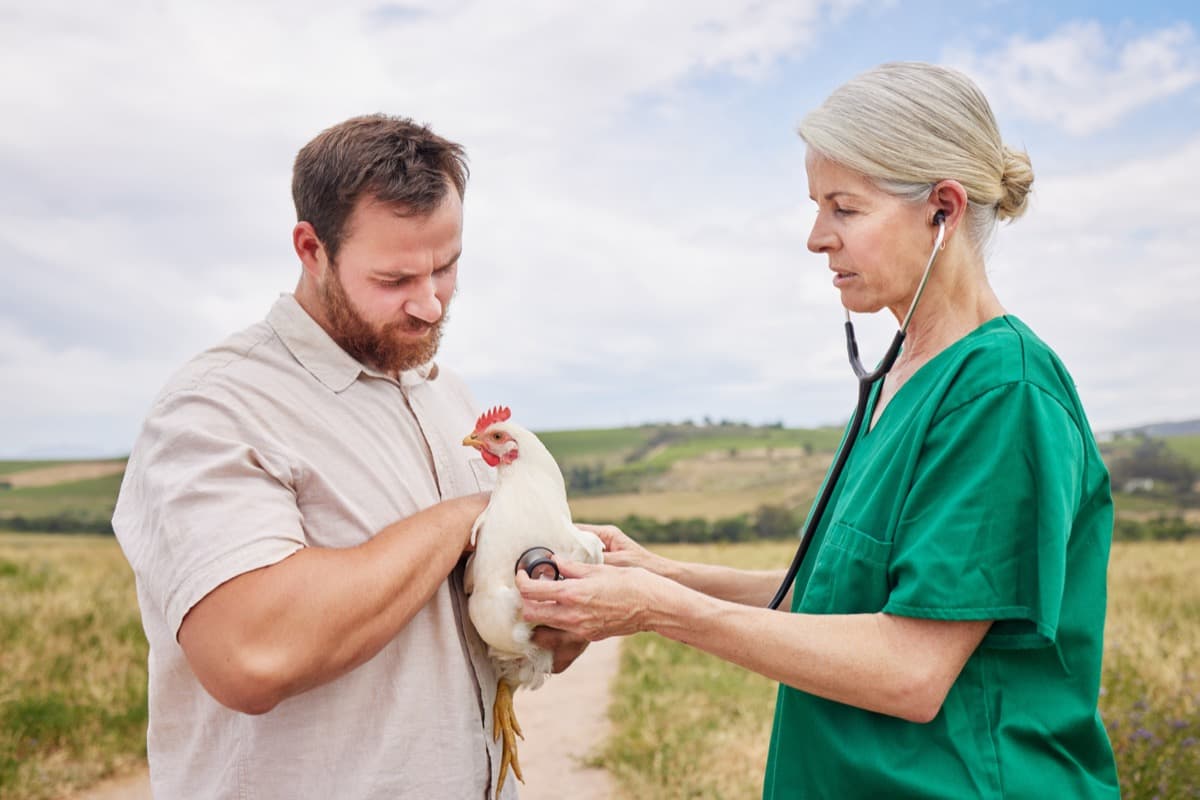Infectious Bursal Disease (IBD) is a viral infection that primarily affects young domestic chickens worldwide. The Birna virus causes the disease (Infectious Bursal Disease Virus) and can lead to symptoms such as depression, watery diarrhea, ruffled feathers, and dehydration. Although mortality is usually low, some virus strains can be highly virulent and cause mortality rates of 60% or higher. IBD diagnoses are typically made by examining lesions in the cloacal bursa and identifying the viral genome.

Infectious Bursal Disease Management in Chicken
Causes of Infectious Bursal Disease
- Birna virus is a virus that belongs to the family Birnaviridae and genus Avibirnavirus.
- The virus is highly contagious and persistent in the environment of poultry houses, where it primarily affects chickens.
- Infected birds excrete the virus in their feces for 10-14 days, and the virus can survive in poultry sheds for up to 120 days.
- The virus can remain viable in water, feed, and droppings from infected birds for up to 52 days.
- The virus is known for its hardy nature, as it can survive heat, cleaning, and disinfection procedures.
- It can also survive in the environment between outbreaks, making it difficult to control. Mechanical vectors such as humans, wild birds, and insects can also play a role in transmitting the virus.
Disease Cycle of Infectious Bursal
- Entry: The virus enters the chicken’s body through the respiratory or digestive tract.
- Incubation: The virus incubates for 3-5 days in the tonsils and respiratory and gastrointestinal tract. During this time, the virus replicates and spreads to other tissues, including the bursa of Fabricius.
- Early clinical signs: The first clinical signs of IBD usually occur around 7-14 days post-infection. These signs include depression, huddling, ruffled feathers, and watery diarrhea.
- Immunosuppression: The virus targets and destroys B lymphocytes in the bursa of Fabricius, leading to immunosuppression. This makes the chicken more susceptible to secondary infections by other organisms, such as bacteria and parasites.
- Recovery or death: Chickens that survive the acute phase of the disease may recover but may also develop chronic infections and suboptimal immune function. Some birds may die from the disease, particularly in the case of very virulent strains of the virus.
- Shedding: Infected birds shed the virus in their feces, which can contaminate the environment and infect other birds. This virus can live in the environment for several weeks to months.
In case you missed it: Newcastle/Ranikhet Disease Management in Chicken: Symptoms, Treatment, Diagnosis, and Prevention

Diagnosis of Infectious Bursal Disease in Chicken
- Clinical signs and gross lesions: The characteristic clinical signs and gross lesions described earlier can provide an initial suspicion of IBD.
- Histopathology: Tissue samples from affected birds can be examined microscopically for the presence of characteristic histopathological changes such as lymphoid necrosis and depletion in the bursa of Fabricius.
- Immunohistochemistry: Specific antibodies can detect the presence of IBDV antigens in bursal tissue sections.
- Virus isolation: The virus can be isolated from bursal tissues or other organs of affected birds and identified through methods such as PCR or sequencing.
- Serology: Blood samples can be collected from birds to test for antibodies against IBDV. Serological tests such as ELISA can be used for this purpose.
- Molecular detection: PCR-based methods can detect the presence of IBDV in blood, tissue, or fecal samples.
Treatment, Vaccination, and Control of Infectious Bursal Disease
- There is no specific treatment for Infectious Bursal Disease (IBD), and control of the disease relies on passive and active immunization and strict biosecurity measures.
- Passive protection of young chicks is achieved through maternal antibodies (MDA) transferred from vaccinated or naturally infected breeders.
- Active immunization is mainly achieved through vaccination. Different types of vaccines are available, including conventional live attenuated vaccines, immune-complex vaccines, recombinant HVT-based vaccines, and inactivated vaccines.
- The use of live attenuated vaccines requires proper timing since MDA can neutralize the vaccine virus. However, these vaccines are effective in providing long-lasting immunity and can be administered two times during the rearing period. Immune-complex and recombinant HVT-based vaccines are typically administered once in the incubator, and replication of the vaccine virus starts once MDA has decreased sufficiently.
- Inactivated vaccines are used in breeder flocks to boost passive protection in the progeny to 4 or 5 weeks.
Preventive measures of Infectious Bursal Disease in Chickens
- Vaccination: Primary and booster vaccinations using live or immune-complex vaccines can be done per the recommended schedule. Inactivated vaccines can be used to boost passive immunity in breeder flocks.
- Maintain high maternal antibodies: Parent stocks should be vaccinated to obtain high maternal antibodies in the progeny.
- Use immuno-stimulants: Include immune-stimulants like Vitamin E in the feed to enhance immunity.
- Provide toxin-free feed: Ensure that the feed given to chickens is free from toxins that can affect the immune system.
- Strict biosecurity measures: Restrict vehicular movements, personnel, and visitors to reduce the risk of transmission. Treat feeders and waterers with 5% formalin, fumigate new poultry sheds with formalin fumes, and dispose of litter, dead birds, and other disposables by incineration or deep burial with slaked lime.
- Control pests: Use pest control measures to prevent the spread of the virus by insects and rodents.
- Clean and disinfect: Strict cleaning and disinfection procedures should be followed to reduce the virus load in the environment and prevent recurrent outbreaks.
In case you missed it: Avian Influenza Management in Chicken: Disease Symptoms, Treatment, Diagnosis, and Prevention

Conclusion
Infectious Bursal Disease is a contagious viral disease that affects young chickens, causing immunosuppression and increasing the risk of secondary infections. There is no effective treatment for the disease, so prevention through vaccination and strict biosecurity measures is key.
Vaccines are available in different types, and their timing should be carefully considered. Preventive measures include strict cleaning and disinfection, pest control, and limiting movements of people and materials. Good nutrition, immuno-stimulants, and toxin-free feed can also help to prevent the disease. By implementing these measures, the risk of IBD outbreaks can be reduced, ensuring the health and productivity of poultry flocks.
- Deworming Schedule for Dogs/Puppies: A Beginners Guide
- How to Prevent and Control Parasites in Goats
- Beneficial Insects in Pest Management
- Natural Solutions for Pest Control in Flower Gardens
- Types of Fungicides Used in Agriculture
- Common Issues in the Fruit Development Stage of Pomegranate Farming
- Fruit Development Issues in Papaya: Easy Solutions and Treatment
- Soil-Borne Diseases and How to Protect Your Plants
- Practices to Prevent Disease Spread in the Garden